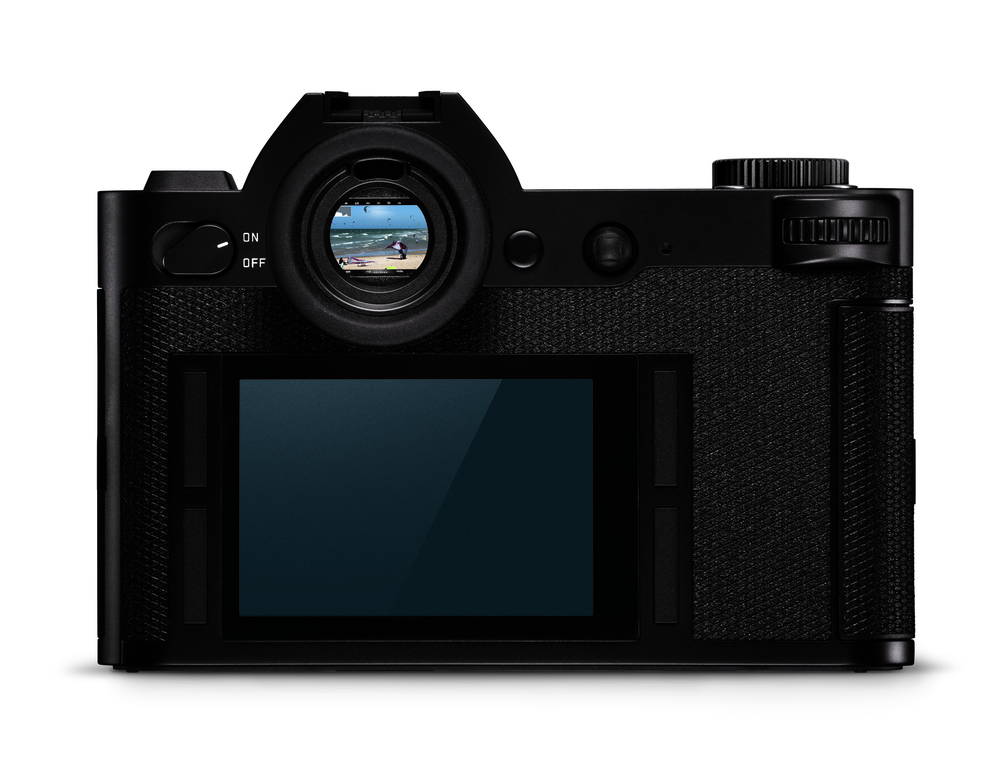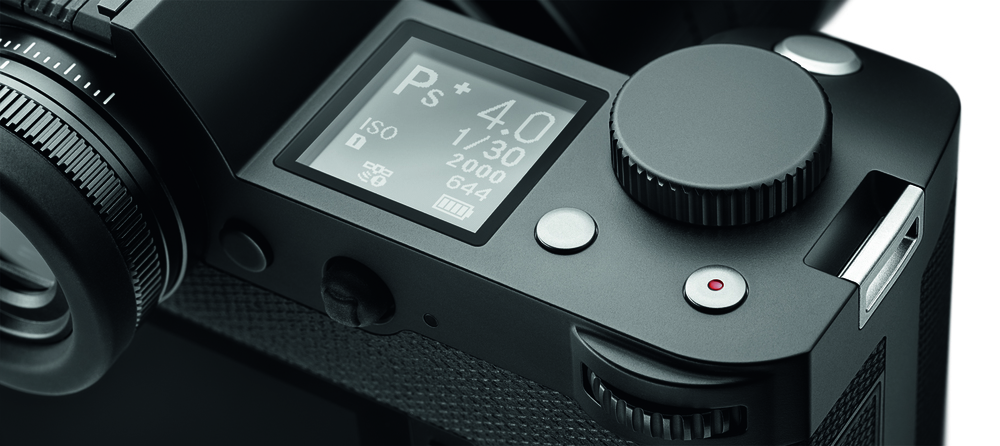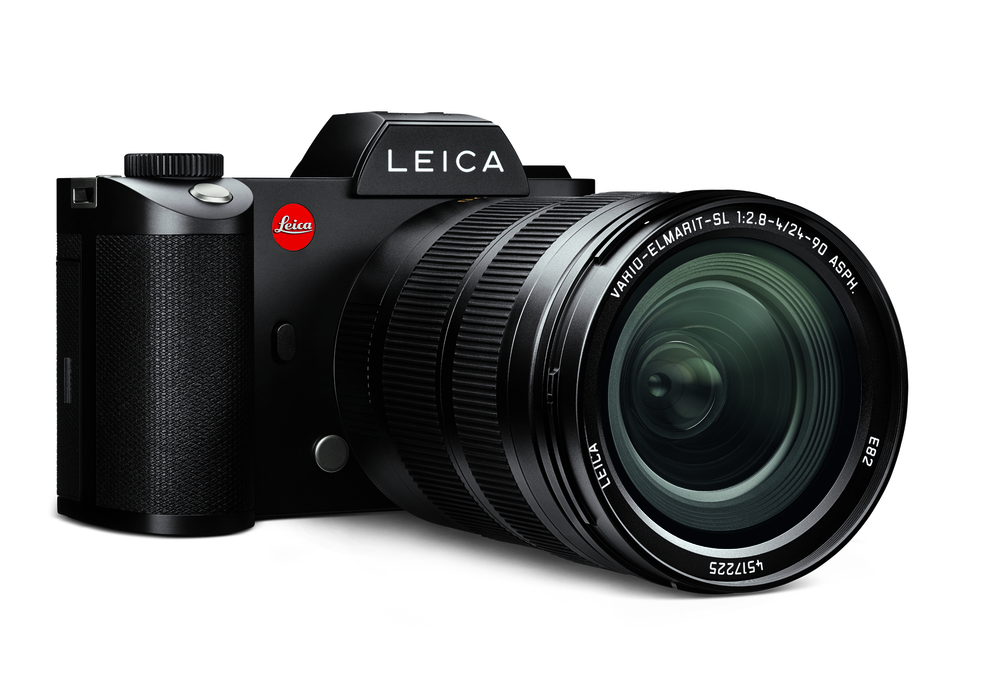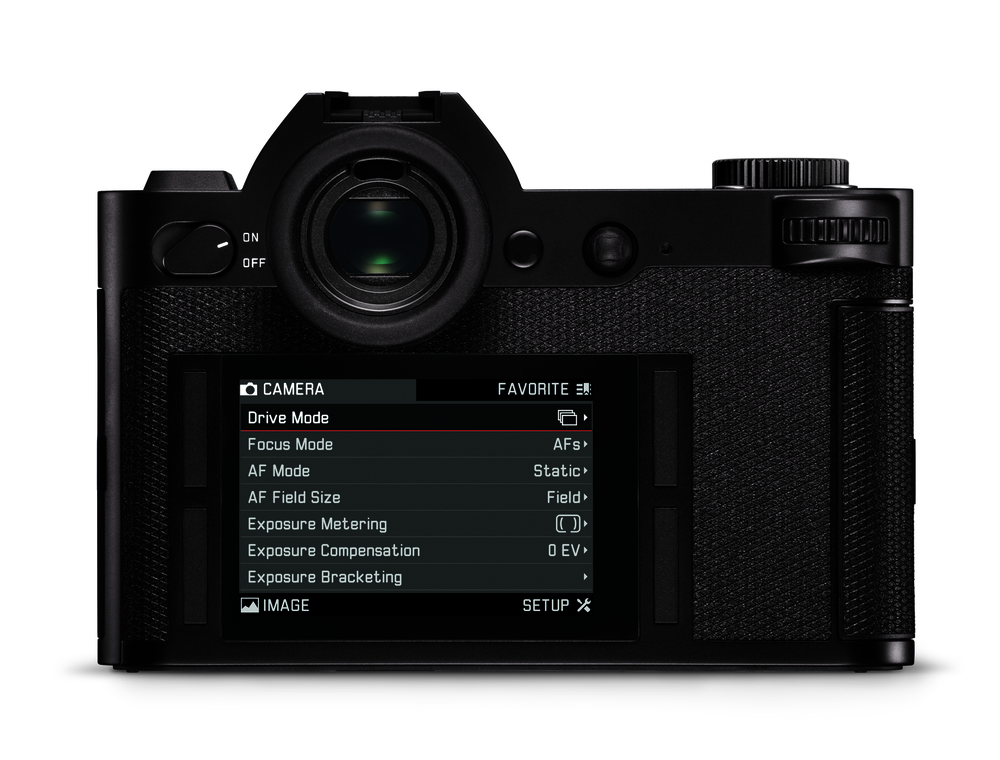Leica has been on a roll for the past couple of years, surprising us with a new APS-C system camera in the polished shape of the T and with the full-frame, fixed-lens Q which has been a major success over this summer. Both these cameras, in their own ways, can now be seen as stepping stones to today’s announcement of a wholly new full-frame system. Taking cues from the T, the Q and, surprisingly the S, the new Leica SL (Typ 601) offers the 24MP CMOSsensor and 2GB buffer memory of the M-P together with the improved Maestro II processor of the Q and the largest, densest electronic viewfinder found on any mirrorless camera.
With its soft controls, mostly devoid of legend, and the top-plate information panel, the SL is more S Light than anything else.
The big surprise, though, is in the adoption of the T mount, now apparently to be called the L mount, to take Leica into the next decade. There will be just one SL lens, the Vario-Elmarit-SL 24-90mm f/2.8-4 ASPH when the camera arrives at dealers in the middle of next month. Later the line-up will be extended with a 90-280mm f/2.8-4 and a Summilux-SL 50mm f/1.4 ASPH. Existing T lenses can also be used but will offer a cropped image.

Leica M lenses will be supported through the existing T-mount adapter and the company has said that the SL is tailored to work perfectly with these manual lenses, a move that will be welcomed by all M owners. R and S adapters will also be available and no doubt third-party suppliers will be adding adapters for other lenses.
With a record 4.4 million pixels, the specially developed EyeRes viewfinder is the largest on the market, comfortably exceeding the already excellent Q finder. The eye cup is reminiscent of the S range while the view offers magnification more in keeping with a medium format camera. It is claimed to offer an entirely new visual experience.
The camera body will cost £5,050 and the 24-90 zoom lens a further £3,150, although I suspect many M owners will initially buy the body alone for use with M lenses.

Leica Press Release
A new milestone in professional photography:
LEICA SL (Typ 601) mirrorless system camera sets new standard in speed, picture quality and versatility
20 October 2015
Leica Camera has today announced the Leica SL (Typ 601), marking the beginning of a new era in professional photography. Made in Germany, the Leica SL mirrorless system camera offers an impressive set of specifications and innovative features, delivering exceptional Leica quality. The camera’s 24 MP full-frame CMOS sensor and perfectly matched components – from the premium- quality SL lenses to the built-in electronic viewfinder – guarantee exceptional imaging performance for professional photographers.
EyeRes viewfinder and touchscreen display for total control of every picture
Developed specifically for the Leica SL, the electronic viewfinder is the first of its kind to feature Leica EyeRes technology. With an imperceptible latency time, an impressive resolution of 4.4 million pixels and magnification reminiscent of a medium format camera, this electronic viewfinder offers an entirely new visual experience and numerous advantages: the final image is visible in the viewfinder before the shutter release is pressed, which enables optimum control over the final picture in any situation. The EyeRes viewfinder is activated simply by looking through it. In addition, the Leica SL features a 2.95” back panel display with a viewing angle of up to 170°, enabling reliable viewing of pictures and efficient touchscreen menu navigation.
Maestro II processor for maximum performance
The high-performance Maestro II Series processor guarantees that photographers will never miss even the fastest-moving subject, and that the camera responds instantaneously to all commands. Combined with the 2GB buffer memory, the processor makes it possible to capture consecutive exposures at rates of up to 11 frames per second at full 24 MP resolution, and 4K video with a frame rate of 30 frames per second. Pictures can be saved simultaneously to an SD card in both JPEG and DNG format, in line with the fast UHS II standard. Thanks to this exceptionally fast processor, the Leica SL achieves the best performance currently possible in the professional camera category, and further highlights the innovative nature of the camera.
24 MP CMOS sensor for exceptional picture quality in 35 mm full-frame format
The Leica SL’s 24 MP CMOS full-frame sensor guarantees impressive dynamic range, excellent contrast rendition, exceptional sharpness, the highest resolution, and noise-free images in almost all lighting conditions. The shutter provides speeds from 30 minutes to 1/8000 sec. The sensor reveals its full potential in combination with Leica SL lenses, especially in available-light situations, and captivates users with atmospheric exposures in superior quality at ISO settings up to a maximum of 50,000. Furthermore, the Leica SL is optimised for use with Leica M-Lenses and, in addition to supporting all their functionality, delivers the excellent picture quality with which Leica has been synonymous for more than 100 years.
The new movie star: professional video in cinematic resolution
The Leica SL is much more than a professional still-picture camera with video recording capability: it fulfils even the most stringent demands of moviemakers as a fully-fledged video camera. Thanks to its 24 MP CMOS sensor and high-performance Maestro II series processor, the Leica SL enables the production of professional videos in 4K resolution. Videos can be recorded in UHD at 30 frames per second or even in Cine4K at 24 frames per second.
In full HD, the Leica SL records video at up to 120 frames per second and makes use of the entire sensor area. Here, the logical and intuitive handling of the camera makes a clear distinction between still- and motion-picture recording. As soon as the camera is in video mode, the display shows only the relevant information for video, such as safe area, aspect ratio, zebra function or the recording level of the microphone. An optional audio adapter allows the user to connect an external microphone and the audio recording level can be set without accessing the menu. Videos can be output in 4:2:2 10-bit format in 4K resolution over HDMI 1.4.
Aluminium body for robust performance in everyday photography
From the beginning, resilience and durability were a key focus in the development of the Leica SL. Body components machined from solid aluminium, and precisely-engineered seals around the controls and in the lenses, provide optimum protection for the sensitive technology inside against dust, moisture and spray. Furthermore, the integrated ultrasonic sensor cleaning function removes dust and dirt from the sensor, when required. The glass covering the back panel display is extremely scratch-resistant and features an anti-reflex coating. All these properties make the camera an ideal tool for use in the challenging conditions faced by professional photographers on a daily basis.
A new generation of lenses for excellent picture quality
The combination of outstanding imaging performance and the fastest autofocus currently available makes working with the Leica SL an entirely new experience, and enables photographers to produce images at a quality level never before seen in 35 mm format. In line with Leica’s high standards of production, the new Leica SL lenses are distinguished by superior optical and mechanical precision.
With its wide range of focal lengths and high speed, the Leica Vario-Elmarit-SL 24–90 mm f/2.8–4 ASPH. is the ideal standard zoom lens in the Leica SL-System portfolio, and will be available at launch. Following this comes the fast Leica APO-Vario-Elmarit-SL 90–280 mm f/2.8–4, and the current lens portfolio is rounded off by the Leica Summilux-SL 50 mm f/1.4 ASPH. – the new reference lens for this focal length. Additional Leica SL lenses will follow.
Furthermore, the exceptional compatibility of the Leica SL-System gives photographers access to almost all Leica lenses ever made. For example, all lenses for the Leica T camera can be used without an adapter. In addition, appropriate adapters allow Leica S, M, and R system lenses and lenses from other manufacturers to be mounted on the Leica SL.
Availability and pricing
The Leica SL (Typ 601) body is scheduled to be available in the UK from authorised Leica stockists from 16 November 2015, at a suggested retail price of £5,050 including VAT.
The Leica Vario-Elmarit-SL 24–90 mm f/2.8–4 ASPH. zoom lens is scheduled to be available at the same time, at a suggested retail price of £3,150 including VAT. The Leica APO-Vario-Elmarit-SL 90- 280mm f/2.8–4 will be available in Q2 2016, and the Leica Summilux-SL 50mm f/1.4 ASPH. will be available in Q4 2016. Prices will be announced nearer to the date of availability.
Additional information can be found at www.uk.leica-camera.com.
LEICA SL (Typ 601) – Technical Information
Lenses
Lens mount: Leica L-Mount
Compatible lenses:
Leica Vario-Elmarit-SL 24–90 mm f/2.8–4 ASPH.
Leica APO-Vario-Elmarit-SL 90–280 mm f/2.8–4
Leica Summilux-SL 50 mm f/1.4 ASPH.
Lenses from the Leica T Camera System, Leica M-Lenses with Leica M- Adapter T, Leica S-Lenses with Leica S-Adapter L, Leica R-Lenses with Leica R-Adapter L and Leica Cine lenses with Leica PL-Adapter L.
Sensor
Type: 24 MP CMOS-Sensor (24 x 36 mm)
Resolution: Full Frame (24 MP): 6000 x 4000 Pixel, APS-C (10 MP): 3936 x 2624
Pixel
Filter: IR-Filter, no Lowpass Filter
ISO: ISO 50 – ISO 50,000
Sensor cleaning: Provided
Processor
Type: Leica Maestro II series
Internal RAM: 2 GB: 33 DNGs or 30 JPEGs and DNGs Image
Image data format: JPEG, DNG
Colour depth: 14 bit (DNG), 8 bit (JPEG)
JPEG: Colour Space Adobe RGB, ECI RGB, sRGB Video
File format: MP4, MOV
Resolution: 4K(4096×2160)@24fps;4K(3840×2160)@25and30fps;1080@ 24, 25, 30, 50, 60, 100 and 120 fps; 720 @ 24, 25, 30, 50, 60, 100 and
120 fps
Bit rate: 8 bit (recording); 10 bit (HDMI not recording)
Colour sampling: 4:2:2/10 bit (HDMI only); 4:2:0/8 bit (recording on SD card)
Video: V-Log L gamma selectable
Audio: Manual/Auto; Stereo microphone, 48 kHz, 16 bit; wind noise elimination Audio external via Audio- Audio-In (3.5 mm phone jack), Audio-Out (3.5 mm phone jack)
Adapter:
Movie length: Max. duration: 29 min, Max. size: 4 GB
EVF
Resolution: SXAG, 4.4 MP
Size: 0.66”
Eye point: 20 mm
Field of view: 37°
Magnification: x 0.80 (With 50 mm lens at infinity, −1 dpt)
Frame coverage: 100%
Diopter correction: − 4 to +2
Eye sensor: Yes
Live View: Operating Modes: Video- and Photo-Live-View separated; Frame rate: up
to 60 fps; Exposure simulation available, Optional information: Focus Peaking, Histogram, Clipping/Zebra, Level, Grid Overlay (3 x 3, 6 x 4), Aspect Ratio (1.33:1; 1.66:1; 1.78:1; 1.85:1; 2.35:1; 2.4:1), Safe Area (80 %; 90 %; 92.5 %; 95 %)
Storage: SD 1 slot (UHS II) with maximum writing speed 100 MB/s, SD 2 slot (UHS I) with maximum writing speed 30 MB/s
Focusing
Type: Contrast AF
Focus modes: AF-S (focus priority), AF-C (shutter priority), MF, Touch-AF AF modes: Static, Dynamic (tracking), Auto (face detection)
AF size: Point, Field, Zone (9 Fields)
37 or 49 Fields
Built in
Program Mode (P), Shutter speed priority mode (T), Aperture priority mode (A) and manual mode (M)
Centre-weighted, Multi zone, Spot
±3 EV in 1/3 or 1/2 EV-steps
3/5/7 images in 1/2/3 aperture steps; additional direct JPEG-HDR
Preset Auto, Daylight 5200K, Cloudy 6000K, Shade 7000K, Tungsten 3200K, HMI 5600K, Fluorescent warm 4000K, Fluorescent cool 4500K, Flash 5400K, Greycard, Manual colour temperature 2000K to 11500K
Focal plain shutter
Single, Continuous slow S (4 fps), Continuous medium M (7 fps), Continuous fast F (11 fps), Self timer 2 s, Self timer 12 s, Interval, Exposure Bracketing, Time exposures up to 30 min
1/8000 s to 60 s, time exposures up to 30 min, Max. frame rate 11 fps
2 years or 200,000 releases
Standard X-jack, Hot shoe with Sync. and TTL-Mode contacts
1/250 s
Built in, IEEE 802.11 b/g/n (2.5 GHz)
Built in, Automatic time and date, Sensitivity < 1°
Rechargeable Lithium-Ion battery, Nominal voltage 8.4 V, Capacity at least 1860 mAh; Lifetime per charge (CIPA): approx. 400 shots; Charging time: approx. 180 min;
Charger: 100–240 V 50/60 Hz 0.25 A with adapters
2.95” Touch Back light LED with Anti-fingerprint and Anti-scratch coating; 1.04 Mio. pixels; Format 3:2; View angle: 170°; Colours: 16 Million; Frame coverage: 100%
1.28” highly reflective monochrome LCD; 128 x 128 dots; View angle 120°; Anti-fingerprint coating
Milled aluminium
Dust/Spray water sealing
USB 3.0 Micro Type B; HDMI Type A; Multi connector adapter for Audio- Out 3.5 mm/Audio-In 3.5 mm; Multi Connector cable release; ISO accessory shoe with centre and control contacts for flash units; Standard X-jack; Multifunctional interface in baseplate for optional handgrip
A 1/4 DIN 4503 (1/4″) with anti-twist locking pin
147 x 104 x 39 mm (W x H x D)
Approx. 771/847 g (with/without battery)
Approx. 0°– 40°C, max. 85 % humidity
Camera body, camera strap, lens mount cap, battery, battery charger with international adapter, USB 3.0 cable, user manual, warranty card, Leica lens cleaning cloth
Remote Control (USB): Leica Image Shuttle SL; Remote Control (Wi-Fi): Leica SL App (Android/iOS)
Two years
AF steps:
AF Assist Lamp: Exposure Exposure Modes:
Exposure Metering Modes:
Exposure Compensation: Exposure Bracketing: White Balance:
Shutter
Type:
Drive Modes:
Shutter speed: Warranty:
Flash
Interface: X-Synchronisation: Wi-Fi:
GPS:
Power Supply:
Touch Screen:
Top Display:
Housing
Material: Sealing: Interfaces:
Tripod thread: Dimensions:
Weight:
Working conditions: Included in the box:
Software: Warranty:
E&OE
LEICA VARIO-ELMARIT-SL 24–90 mm f/2.8–4 ASPH. – Technical Information
Angles of view
(diagonal, horizontal, vertical):
At 24 or 90mm: approx. 82.4°, 72.1°, 51.8° or 27.8°, 23.3°,15.7°
Optical design
Number of lenses/ groups:
18/15
Aspherical surfaces:
4
Position of the entrance pupil (when infinite):
At 24 or 90mm: 103.9 or 92.6mm (in the direction of light incidence in front of the bayonet fitting contact area)
Image stabilisation:
Multiple axis system, stabilisation performance 3.5 shutter speed stages in accordance with CIPA testing conditions
Distance setting
Either automatic (Autofocus) or manual, modes are set on the camera
Focusing range:
At 24 or 90mm: 0.3 or 0.45m to ∞
Smallest object field/ Biggest scale:
At 24 or 90mm: approx. 173 x 260mm/1:7.2 or 92 x 137mm/1:3.8
Aperture
Setting/Function – Electronically controlled aperture, setting via turn/push wheel on camera, half values can also be set
Lowest value:
22
Bayonet fitting:
Leica L bayonet fitting with contact strip
Filter mount/lens hood:
External bayonet fitting for lens hood (included), internal thread for E82 filters, filter mount does not rotate
Finish:
Black anodised
Dimensions and weight
Length of the bayonet fitting contact surface:
At 24 or 90mm, (without/with lens hood) Approx. 138/170mm or 182/212mm
Largest diameter:
Approx. 88mm
Weight:
Approx. 1,140g
Warranty:
Two years
E&OE



Living in Australia I woke up to a beautiful morning refreshed and eager to read about the new Leica camera . And I was disappointed. As a Leica user since 1968-I currently own six-I hardly fall into the large group of Leica knockers who no doubt are already expressing their views forcibly on the forums but I do find myself scratching my head at the SL. I guess the biggest disappointment is the pricing. What are those folks in Wetzlar smoking? The Aussie pricing has not yet been announced but I reckon that I could buy three Sony a7 bodies for the price of one SL body. Now the SL maybe a thing of exquisite engineering and beauty but there are limits to premium pricing and Leica have exceeeded them for me.If the local pricing follows the US -which it invairably does-then an SL with a lens will only cost marginally less than a new small car. Which is silly.
My second disappointment is the size and look of the camera. Why does it have to look like a big Sony a7? Leica have done a wonderful job with the styling of the Q so why is the SL so "me too"?
Also it is so big and so heavy.The whole rationale of Barnack’s first Leica was a pocket camera you could take hiking.In recent years only the X1 and X2 (ignoring the Panasonic derived cameras) meet this design brief.The SL is a great lump as are the lenses.Hardly a great travel camera and not for hiking unless you have a porter with you.
Then there is the question of Leica’s product strategy. Where does the SL fit? Why the S and the SL? They seem to be very similar in market positioning. Where does the orphan T camera fit? Is it a case of "tried that did not work let’s move on" with the T? And where do the X cameras fit.The X1 and X2 really fitted Barnack’s brief but since then the X and particularly the XVario are much bigger cameras.I own an X Vario.The IQ is wonderful but it is hardly a travel camera despite Leica’s claims.
To me there is no overarching product strategy.It seems a muddle.I hope that their finances are strong enough to finance all these model lines.
My final disappointment is that I have had a look at some of the SL images which have been put up by various photographers who were lucky enough to have been chosen to trial the SL before release.Now one thing which may make the SL more acceptable to me and I guess many others are if the IQ is extraordinary.This means having images up there today which make one go"wow I understand now".Well none of the images I have seen so far even come close to this.In fact I have just looked at a set of photos by one well known Leica exponent which are to put it politely very ordinary. Photographically they are mediocre and they say nothing about the SL. They could well have been taken with a cheap point and shoot. Leica really need to get their ducks in the row on this aspect of their releases.This is not the first time the images by the "insider" Leica photographers have been underwhelming.They need world class breathaking images to support their press releases.Giving cameras to Leica mates does not seem to be producing those images.Time to try a different approach.
So a very disappointing morning but it’s still a beautiful day nonetheless.
—
http://therollingroad.blogspot.com/
At last! The SL was hinted at by naturephoto1 (Rich) on the Leica Forum in November 2014 when he referred to a conversation with Stefan Daniel and James Lager … but forum members did not take much notice:
http://www.l-camera-forum.com/topic/214267-the-sony-a7-thread-merged/?p=2701351
… now I’m trying to find a way of funding an SL camera … still have my R lenses but should not have bought the secondhand A7R last August.
dunk
Dunk, There have been lots of rumours about the SL although until recently no one pinned down the detailed spec. Many writers, myself included, signed non-disclosure agreements months ago and have had to sit on the sidelines while all the guessing went on.
I like the SL, particularly for its S Light credentials: It has many similarities with the S. My main reservation is size/weight. Having given up heavy DSLR great many years ago, I feel I am now too old to want to cart around something that weighs as much.
That said, I think the SL will perform really well with M lenses and could be a viable alternative for many M owners. I can’t wait to try it with my Tri-Elmar MATE.
As for Sony, as you know I have dabbled with the A7R/A7II and have paid special attention to using these cameras with Leica lenses. But there are compromises and I think the SL will be a much better match for M lenses. Apart from that, I am fed up with Sony’s too-frequent model changes, total lack of firmware support for older models, poor battery life, noisy shutter and, above, all, impenetrable menu system. On the other hand, the A7 is compact and light, unlike the SL.
I shall be having a closer look at the SL tomorrow (October 22) at the Mayfair press conference. I’ll have a better idea then of whether I will be a potential SL owner.